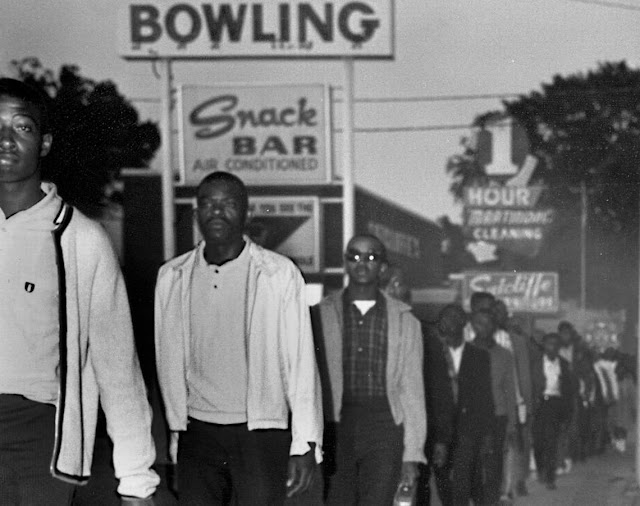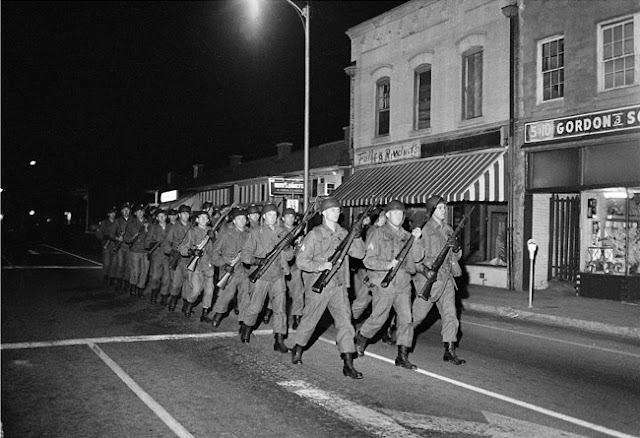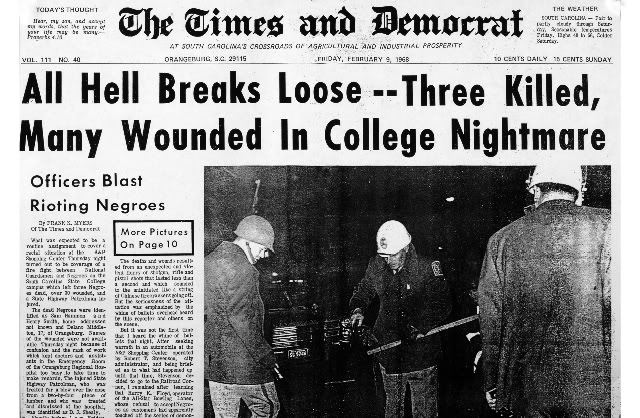1968
was one of the most eventful years
in American history—the Vietnam War raged. Riots
expressing Black rage tore up inner
cities. Chicago Police themselves
rioted, beating and gassing demonstrators at the Democratic Party Convention. Martin
Luther King and Robert Kennedy were
assassinated. Richard Nixon
was elected President. Apollo astronauts first orbited the Moon.
Maybe that explains how the first shooting of students on campus by authorities on February
8, 1968 gets overlooked. But how
do you explain the fact that even then, it barely caused a ripple in the
national consciousness?
Students at historically Black South Carolina State College (SCSC) at Orangeburg just wanted to bowl. Although certainly not untouched by
more than a decade of Civil Rights
turmoil in the South, students
there, typically the first in their families to go to college, usually
concentrated on their studies. It
was certainly no hotbed of radicalism.
Like many small towns, recreational
opportunities were limited. Just
outside the University sat the town’s only bowling alley, All Star Bowling Lanes, on US 301 owned by Harry K.
Floyd. It had a firm Whites Only policy. On February 6 a large group of students
attempted to enter the bowling alley.
They were refused admission.
Scuffling broke out and local police were called. In the resultant melee nine students
and one officer were injured. Two
female students were restrained by one officer while being beaten
by another. The campus erupted in
rage.
Rowdy demonstrations and arrests
occurred the next evening. Students
announced that they would keep up street actions. Local officials called for help. Governor
Robert E. McNair mobilized a National
Guard unit and dispatched large numbers of State Police to Orangeburg.
On the night of February 8, students
started a large bonfire in the
street near the bowling alley. Bottles
and rocks were thrown at massing authorities. There were claims that at least one Molotov cocktail was thrown. The Fire
Department was called to douse the bonfire and the State Police advanced
“in protection” of firefighters.
Students fell back to campus exchanging jeers and insults
with police and throwing objects at them.
The crowd of 200-300 students stopped just inside the entrance of
the school.
One police officer suffered minor
injuries to the face when struck by a piece of banister railing. Police later said that they came under fire
from snipers. Some witnesses recall two or three popping
sounds. Much later it was determined
that an Orangeburg city policeman
fired three warning shots into the
air with his carbine.
Unnerved and enraged the State
Police unleashed multiple volleys at
the students at a range of about 20 yards.
The Police were armed with sawed-off
riot shot guns. Ordinarily these
weapons are supposed to be loaded with light
bird shot for non-lethal crowd
control. The pump action shot guns
instead were loaded with heavy buck shot,
nine pellets to a cartridge and designed to kill.
In moments three young men lay dead. At least 26 others were shot, most in
the back while fleeing.
Many had multiple wounds from the devastating buck shot. Forty years later, another man showed a scar
and said he was shot in the stomach that night but was afraid to seek
treatment. After the shooting
stopped, two students were beaten, one for questioning the Police. Twenty-seven year old Louise Kelly Cawley was beaten and sprayed in the face with Mace while trying to bring the wounded
to medical treatment. A week later she
suffered a miscarriage as a result of her injuries.
The dead were SCSC students Samuel Hammond, 18, Henry Smith, 19 and Wilkinson High School senior Delano Middleton, 17.
That night the Associated Press (AP)
reported the shootings as a “heavy exchange of gunfire” with
authorities. It never corrected
this entirely erroneous report.
The next morning Governor McNair
told reporters it was “one of the saddest days in the history of South
Carolina.” He fretted that the state’s,
“reputation for racial harmony had been blemished.” He was also a fount of misinformation
not only backing claims that the police were fired on but claiming that the
shooting occurred off campus as students were rampaging. He also blamed “Black Power advocates” for the unrest. National news outlets did little to counter
this biased account, which became widely accepted.
The Justice Department launched an investigation. Eight of 66 State Police on the scene admitted
firing their riot guns, most of them multiple times. A ninth officer emptied the six bullets from
his .38 service revolver at fleeing students. They were indicted for “imposing summary
punishment without due process of law.” The officers were: Patrol Lieutenant Jesse Alfred Spell, 45, Sgt. Henry Morrell Addy, 37, Sgt.
Sidney C. Taylor, 43, Corporal
Joseph Howard Lanier, 32, Corporal
Norwood F. Bellamy, 50, Patrolman
First Class John William Brown, 31, Patrolman
First Class Colie Merle Metts, 36, Patrolman
Allen Jerome Russell, 24, and Patrolman
Edward H. Moore, 30. All were
white. An Orangeburg city police
officer, later promoted to Chief,
also discharged his shot gun but was never charged. Later another State Police officer, Patrolman Robert Sanders, admitted
shooting students but was never charged.
It took less than two hours for a jury
to acquit all of the officers
despite the fact that evidence presented at the trial was damming. No guns were ever found among the victims nor
did any eyewitnesses report seeing any or hearing any gunfire from the crowd.
Two and a half years after the
shooting, one man was finally convicted—Cleveland
L. Sellers, Jr. He was a young South
Carolinian who was National Program
Director for the Student Nonviolent
Coordinating Committee (SNCC). He happened to be in Orangeburg on February
6. He had been present at the first
disturbance outside of the bowling alley and had been injured. He was not there in his capacity with
SNCC. The organization never had a campaign
at the school, and he was not present or involved with events over the next
two days. None-the-less, state
authorities, hoping to shore up their weak case for “outside agitators,”
charged Sellers with multiple counts, including conspiracy and incitement
to riot. This was too much for even a local
trial judge, who threw out the felony counts with scathing remarks. But he did find Sellers guilty of simple
riot. Sellers spent 7 months in state
prison. In 1998 Sellers published a memoir
of his ordeal, Orangeburg Massacre: Dealing Honestly with Tragedy and Distortion.
Jack
Bass’s comprehensive 1970 account, was, despite glowing early reviews,
effectively squelched in distribution by pressure from Federal Bureau of Investigations (FBI) chief J. Edgar Hoover, who objected to accounts of FBI agents attempting
to cover up for the State Police.
The book was finally re-issued and became widely available by Mercer University Press in 1984.
Bass continued as an historian to
campaign for wider awareness of the buried incident.
In 2004 South Carolina Governor Mark Stafford finally issued a public
statement that, “I think it’s appropriate to tell the African-American community in South Carolina that we don’t just
regret what happened in Orangeburg 35 years ago—we apologize for it.”
The Orangeburg Massacre memorial on the grounds of South Carolina State University today.
The school is now known as South
Carolina State University. Its gymnasium
is now named in memory of the three men killed.
There is a monument on campus in their honor and the site of the
shooting is marked. The school conducts annual memorial
commemorations and promotes ongoing academic investigation of the
event.
And, oh yeah, the All Star Bowling
Lanes was renamed the All-Star Triangle
Bowl. The Floyd family still owns and operates the business. It has been integrated for many years.







No comments:
Post a Comment